An Ambiguous Monument
- Hans Erik Havsteen, arkivet.thorvaldsensmuseum.dk, 2017
- Translation by Karen Jelved, Andrew D. Jackson
On the death of King Frederik VI in 1839, a group of farmers and public servants from Jutland asked Thorvaldsen to execute a monument to the late King. Thorvaldsen accepted, and the monument was erected on the hill at Skanderborg Castle in 1845. The motivation for the form of the monument reveals interesting views regarding a free constitution and civil rights in Denmark in the 1840s.
On the hill at Skanderborg Castle there stands a monument to the absolute monarch Frederik VI, executed by Bertel Thorvaldsen in the 1840s. The neoclassical monument is certainly not among Thorvaldsen’s best-known works although it is one of the early public monuments in Denmark and an interesting example of the special relationship between Thorvaldsen and the Danish monarchy. The appearance of the monument is quite different from that of e.g. the monumental expression of the Liberty Memorial on Vesterbro or the absolutist staging of the monarch of the equestrian statue on Amalienborg Palace Square. Bertel Thorvaldsen executed the four marble reliefs of the Skanderborg monument, The Abolition of Villeinage, cf. A604, The Establishment of Provincial Consultative Chambers, cf. A605, Justice, cf. A606, Protection of the Arts and Sciences, cf. A607, and a bust of Frederik VI, cf. A191.

Fig. 1. The monument to Frederik VI, the hill at Skanderborg Castle. 1845.
However, the political and ideological conflicts that accompanied the genesis of the royal monument are unknown to most modern observers. This genesis is far from uninteresting and sheds light on many of the issues connected with the period preceding the abolition of absolute monarchy such as a free constitution, freedom of expression, and the relationship between monarch and subject. Therefore, it can be useful to study sources in The Thorvaldsen Museum Archives in order to try to answer the following questions concerning the development of the ideas behind the monument and its erection: Why would a liberal and progressive artist like Thorvaldsen even consider paying tribute to a conservative and reactionary sovereign like Frederik VI with reliefs containing allegorical symbols of liberty? Why would a group of liberal owner-farmers and public servants be interested in supporting the erection of a monument to a king whose reign for the most part had done nothing but cause national disasters, and who actually fought these liberal movements? Finally, one might wonder why a royal monument was to be placed on the hill at Skanderborg Castle, a place to which Frederik VI was not closely connected.
The Superstar and the Absolute Monarch.
Neither Thorvaldsen nor later art historians have maintained that the absolute monarch Frederik VI was a great expert on art. Quite the opposite was probably true. In 1784 at the age of 16, Frederik VI seized power from his insane father, Christian VII, in a palace revolution. He became one of the longest reigning rulers in the history of Denmark even though he did not officially become king until 1808. He was notorious for his preference for military matters, in particular drills and discipline, and he had no interest in artistic matters. His reign can be divided into three periods. During the first period from 1784 to 1797, the government was led by progressive noblemen like the Reventlow brothers and A. P. Bernstorff who encouraged the young Crown Prince to effect great reforms particularly in agriculture. During the second period (1797-1814), Frederik developed a firmer grip on government, first as Crown Prince and from 1808 finally as King. These years were characterized by wars in which Denmark lost both its great navy and Norway and in 1814 became the loser in a major European conflict that resulted in a burnt-down capital and an economy in ruins. The last part of his reign, 1815-1839, is often characterized as the reactionary years, when the King did his best to fight democratic and liberal initiatives like monarchs all over Europe.
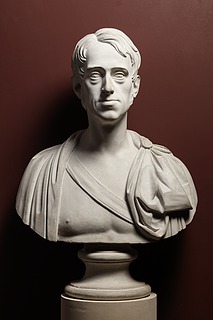
Fig. 2. Thorvaldsen’s bust of Frederik VI was executed during Thorvaldsen’s stay in Denmark 1819-20. Plaster. A191.
Frederik VI was the reigning monarch during the greater part of Thorvaldsen’s life, from his youth at the Academy of Arts until Thorvaldsen as an elderly man returned to his native country in 1838. Even though the course of their lives ran quite parallel (Frederik was born in 1768, Thorvaldsen in 1770), their lives must be said to be diametrically opposite. One a popular superstar from a working-class background in Rome, the art mecca of the time, the other an absolute monarch of an ancient dynasty in a minor European state. Judging from Frederik VI’s political standpoint, one would expect that Thorvaldsen, with his egalitarian views, would not want to pay tribute to the late King. One might wonder why a freedom-loving artist like Thorvaldsen would want to execute a monument to a very conservative and reactionary absolute monarch, whose government represented the very things that progressive forces like Thorvaldsen and those similarly disposed were trying to overthrow.
Paradoxically, it seems that Frederik VI’s lack of interest in art suited Thorvaldsen very well. Over the years Thorvaldsen had executed many works for the Danish royal family, and even though Frederik VI may not have been enthusiastic about art, he knew that art was part of an absolute monarchy and good for his reputation. In short, Frederik VI was a good contact and a customer who did not interfere in Thorvaldsen’s artistic process, and Thorvaldsen liked that: He spoke about Frederik VI with great affection and devotion. “He was no expert on art, but then he did not pretend to be.” Besides, Frederik VI had actually played a practical role in Thorvaldsen’s life on several occasions. Thorvaldsen’s recognition of Frederik VI might be due to the fact that he did not force Thorvaldsen to return to Denmark in spite of repeated requests to do so when his travelling grant had expired but rather prolonged it. Thorvaldsen may also have been grateful for Frederik VI’s donation of the carriage house on Slotsholmen as the base of the later Thorvaldsen’s Museum. Finally, Frederik VI had in 1833 given Thorvaldsen permission to adopt his illegitimate daughter Elisa Paulsen as his lawful daughter and heir, a very serious and complicated matter at that time. So, Frederik VI had exercised a positive influence on Bertel Thorvaldsen’s professional and private life.
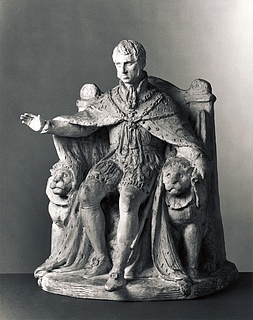
Fig. 3. A first model for a monument in the King’s Garden? Plaster. A141.
In connection with the King’s death 3.12.1839, both C.F. Wilkens and J.M. Thiele maintained that Thorvaldsen on his own initiative began a model for a monument to the late King, which, according to Wilkens, was to be placed in The King’s Garden near Rosenborg Castle. At any rate, Thorvaldsen produced a model for a monument to Frederik VI in December of 1839, which seems to indicate that Wilkens and Thiele were not altogether wrong. This model shows Frederik VI in coronation robes. There is absolutely no doubt what type of sovereign Frederik VI represented in Thorvaldsen’s view. The model must be seen as proof of Thorvaldsen’s personal interest in a monument to Frederik VI. The ubiquitous Thiele had reacted very quickly himself and, already two days after the king’s death, had written to Thorvaldsen with a detailed proposal for an equestrian statue to be placed on Esplanaden in Copenhagen. However, Thorvaldsen did not comply with this request but continued working on his model of a seated Frederik VI in coronation robes. For unknown reasons, the new King Christian VIII did not like this idea, which must have irritated Thorvaldsen. From Thorvaldsen’s point of view, this reaction must have been in sharp contrast to Frederik VI’s indifference to questions concerning art, but it is possible to see the disagreement as an expression of a general struggle for power between Thorvaldsen and Christian VIII, in which the King wanted to put Thorvaldsen in his place. Unlike his predecessor, Christian VIII took an interest in and was knowledgeable about art and culture. Another explanation of Christian VIII’s dissatisfaction with the monument to Frederik VI might be found in the absolutist character of the proposed model. Liberal circles had hoped for a free constitution as soon as Christian VIII ascended the throne. However, they were soon disillusioned, and Christian VIII may not have wanted to provoke the population needlessly with a monument to Frederik VI in coronation robes in the middle of the King’s Garden.
The Birth of the Frederik VI Commission
Even though Christian VIII at first rejected Thorvaldsen’s plans for a monument to Frederik VI in the capital, it was not long before other proposals were made for a public monument to the late monarch. At the beginning of 1840, two farmers from Jutland, C. Dalgas and Johannes Ingwersen, proposed a monument to Frederik VI on Himmelbjerget in Jutland. Frederik VI had never had much to do with Himmelbjerget, but at this particular time, the poet Blicher held his Himmelbjerg festivals with wide popular participation. Himmelbjerget was thus associated with what was popular and Danish, so if one wanted to emphasize that Frederik VI was close to the people, the location on Himmelbjerget was very suitable. Incidentally, one of the proposers, C. Dalgas, was the brother of Christine Stampe, Thorvaldsen’s friend and patroness, which illustrates how closely connected Thorvaldsen’s clientele was.
At this time, public monuments were a relatively new phenomenon. There were a few, like the equestrian statues of Christian V and Frederik V and the Liberty Monument, but they were all in Copenhagen. With a few exceptions, such as Sandflugtsmonumentet in Tisvildeleje from 1736, nothing of interest was to be found in the provinces. The monuments mentioned, apart from the Liberty Monument, had all been erected by the Crown. (It is true that the equestrian statue of Frederik V had been paid for by East Asiatic Company, but this was in fact controlled by the Royal Court.) It was a new phenomenon for the people to take the initiative to erect monuments, a sign of the political ferment in society in the 1830s and 1840s. Besides e.g. the Hans Tavsen Memorial in Viborg from 1836 (executed by H.E. Freund), there were very few public monuments in Jutland and in the rest of the country. This eagerness to have artistic monuments from the capital brought to the provinces was not unknown at the time. During the national subscription for Thorvaldsen’s Museum in the 1830s, there had been protests from the Duchies against having to pay for cultural projects that only the citizens of Copenhagen would enjoy. Even though the liberal Danish farmers and the pro-German inhabitants of Schleswig-Holstein did not like each other, they were able to join, without coordination, in turning against the centralist, absolutist government in Copenhagen. The erection of monuments was quite simply a way of participating in the public debate and to hold their own against the ruling class in the capital.
From the very beginning, it was clear that Ingwersen and Dalgas wanted a radically different monument from what both Thiele and Thorvaldsen had had in mind. Gone was the idea of the monarch on horseback à la Saly’s Frederik V, and the coronation robes and the throne were also absent from Dalgas’ and Ingwersen’s proposal. Instead the monument was to emphasize the Emancipation of the farming class, i.e. the abolition of villeinage from 1788. That this element was stressed in the proposal should be seen as a reflection of the fact that the social class to which both Johannes Ingwersen and C. Dalgas belonged had benefitted most from the agrarian reforms of 1788.
Ingwersen’s and Dalgas’ proposal, which was primarily advanced in the newspaper Aarhus Stiftstidende and reprinted in various other provincial newspapers, met with both support and opposition. A long controversy in the press started in the spring of 1840 between opponents and supporters of a monument to Frederik VI. Therefore, the available source material regarding the elucidation of the Frederik VI Commission, its members, and its motives is quite substantial. At this time, the leading advocates for the monument were Johannes Ingwersen and C. Dalgas. Their affiliation to the class of owner-farmers, the class that had benefitted most from Frederik VI’s agrarian reforms, meant that gratitude for these social reforms should be expressed in the monument. Furthermore, the monument must be placed in Jutland and not in the capital. Dalgas and Ingwersen were thoroughly fed up with dominance of the capital, which in their opinion attracted all art and thus achieved a good deal of PR. A national subscription would draw attention to the project and the social class that had made the proposal. Jutland also “needed embellishments”, a claim that perhaps only people from Jutland can make. Dalgas’ and Ingwersen’s idea met with sympathy particularly among members of the class of owner-farmers in Jutland, several of whom later supported the project.
However, the originally planned location on Himmelbjerget near Silkeborg had encountered problems as the owner of the hill was not inclined to give his permission, so it became necessary to find alternative locations. The choice fell on the hill at Skanderborg Castle, the ruin of an old castle of which only the church remained (as it still does). Even though Frederik VI had not had any close contact with Skanderborg either, the place represented a close connection with the Crown because kings, among them Frederik II and Frederik IV, had resided in the castle since the Middle Ages. In addition, Skanderborg was situated in the middle of the country and not in a remote part of the realm. In that way, it would be easier for the entire population to visit the monument. Symbolically, the hill at Skanderborg Castle, with its close connection with the Crown, was perhaps even better suited than Himmelbjerget, which was more closely associated with popular sentiments because of Blicher’s Himmelbjerg festivals. C. Dalgas emphasized that it was a memorial and not a liberty monument, which would not be relevant until the introduction of a free constitution.
A commission, the Frederik VI Commission for a monument to Frederik VI, is mentioned for the first time in a letter dated July 1840. Here, J.P. With contacts Thorvaldsen and asks him to execute three reliefs for the monument. The letter also mentions the idea of a national subscription as the primary source of financing. With, the author of the letter, was a friend of the politician J.F. Schouw, the brother-in-law of Christine Stampe and C. Dalgas. The group of people that gathered in the Frederik VI Commission either belonged to or had close contact with the progressive and liberal elite – an elite that was very closely connected. Thorvaldsen’s answer to this letter is not known, but the Frederik VI Commission had invited the inhabitants of Jutland, the islands, and Schleswig-Holstein to contribute to the monument. This time, the sender of the public invitation was Hans Wulff, another farmer from Jutland, who had joined the commission. C. Dalgas resented Wulff’s interference in the work of the Commission. The resulting dispute between the two had nothing to do with the monument and must have been a personal quarrel. The result of this ludicrous argument was that C. Dalgas, who had spent a lot of time on the project in its early phase, left the commission in anger.
At some point during the autumn of 1840 Thorvaldsen agreed to execute the reliefs for the monument. This is made clear in an article in Aarhus Stiftstidende, in which the members of the Commission, this time without the temperamental Dalgas, also invite citizens to send in contributions and announce an impending election of a committee. In the course of the spring of 1840, contributions to the monument began to come in from all parts of the country, but only slowly. In July 1841, a mere 2784 rix-dollars had arrived of the about 14,000 thought necessary. At a meeting in August 1841 in Skanderborg, a committee was finally elected, consisting of Colonel Rosenberg, the above-mentioned Counsellor Wulff, Major Ingwersen, Counsellor With, and Counsellor Blichfeldt. This group of prominent Jutlanders, several of whom had had a career in the military or in public administration, was to deal with the practical work concerning the monument, e.g. the continued financing and the procurement of permissions for use of land, etc.
The Individual Parts of the Monument
The members of the Commission wanted to focus on Frederik VI’s merits as a king, i.e. the abolition of villeinage, the introduction of the provincial consultative chambers, and the education act. The abolition of villeinage was part of a large reform package, the agrarian reforms, which Frederik VI as Prince Regent had implemented in 1788 at the request of experienced advisors. These reforms were quite extensive and meant, among other things, a more efficient exploitation of farm land, clearer proprietary rights, and, of course, the abolition of the hated system of villeinage, which prevented a farm hand from leaving the squire’s land from the age of 4 until the age of 40. It is true that these reforms had given the farming class greater economic and personal freedom. The owner-farmers benefitted greatly, but a large and poor agricultural proletariat arose in the wake of these reforms. However, the Frederik VI Commission consisted of owner-farmers and public servants and not of members of the agricultural proletariat. Therefore, they had every reason to celebrate the abolition of villeinage.
The Provincial Consultative Chambers were established in 1834 and resulted in involving more social classes in political life. Therefore they have often been seen as the first step on the road to the democratic Constitution of 1849, even though their function was consultative rather than legislative. There were three groups: landed proprietors, yeomen and tenants, and house owners in towns. The composition of the groups was not democratically divided according to size, and only 3% of the population had the right to vote for the Consultative Chambers. As mentioned, the King did not have to follow the Consultative Chambers, but they did have an important voice in the political debate in the 1840s. There were four Consultative Chambers: one for Zealand and the islands in Roskilde, one for Jutland in Viborg, one for Schleswig in the town of Schleswig, and one for Holstein in Itzehoe. Even though the King was not bound by the advice of the Consultative Chambers, the situation in the 1840s developed in such a way that they put great pressure on the King and his officials. The final demand, specified by the Commission with regard to the monument concerning education, refers to the Education Act of 1814, when Denmark was the first country in the world to introduce compulsory education for pupils in towns as well as in the country.
The final result, which was inaugurated in a big celebration on the hill at Skanderborg Castle in 1845, however, differed from the original ideas. As mentioned above, Thiele had suggested an equestrian statue, and Thorvaldsen had worked on a model of the king in coronation robes. The Fredrik VI Commission, however, changed the form dramatically. The first thoughts of the Commission regarding a monument to Frederik VI was expressed in With’s letter dated July 1840, but these first proposals also differed from the final result. The Commission wanted four reliefs on an obelisk (the similarity to the Liberty Monument on Vesterbro, which celebrated the agrarian reforms, is evident), a relief with the King’s portrait and three reliefs “which referred to the abolition of vileinage, the Provincial Consultative Chambers, and education”. These three political initiatives were considered to be the most important in the long reign of the King. That is, the prosperous part of the agricultural community, which the Frederik VI Commission represented, considered these elements to be important. They had ensured economic, political, and educational progress for the owner-farmers. Therefore, the people who commissioned the work had a clear picture of what the allegorical focus of the monument should be. Their views regarding the choice of artist are not known, but already at the early stage of the process, Thorvaldsen was mentioned as the artist who was to be in charge of the project even though the members of the commission did not go into details as to the imagery and the form of the work beyond the allegorical considerations. Thorvaldsen’s reputation and artistic focus was at this time so solid that his participation would ensure a good deal of prestige. Besides, they must have had an idea of what artistic expression they would get by choosing Thorvaldsen. No alternative choice of artist is mentioned.
Thorvaldsen must have used the considerations of the Commission as his point of departure, but he ended with four reliefs and a portrait bust on a granite column instead of four reliefs, one of which was to have been a portrait of Frederik VI. Thorvaldsen adorned the reliefs with an allegorical imagery that he often used.
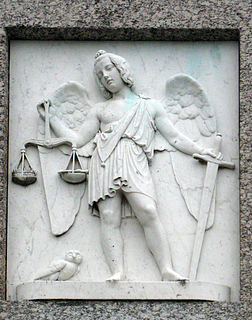
Fig. 4. Justice. Marble, cf. A606. The front of the monument.
The relief Justice, cf. A606 had the honour of being the most prominent on the front of the monument. In the relief, a genie weighs the farmer’s sickle against a crown and leans on the sword in his other hand. Both the scales and the sword are the traditional attributes of Justice. The owl of wisdom is at the genie’s foot. The relief can probably be seen as a reference to Frederik VI’s motto, God and the Just Cause.
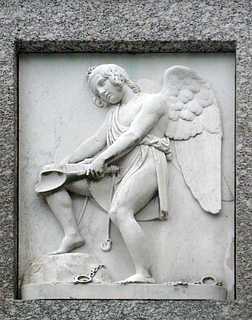
Fig. 5. The Abolition of Villeinage. Marble, cf. A604. The left side of the monument.
On the left side of the monument is the relief The Abolition of Villeinage, cf. A604, in which a genie breaks the farmer’s yoke, and the serf’s shattered chains are seen on the ground. These attributes must be seen as a clear reference to the abolition of villeinage in 1788 and the decree about the abolition of the slave trade in 1792.
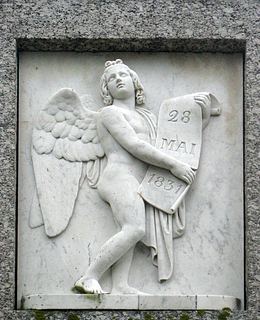
Fig. 6. Protection of the Arts and Sciences. Marble, cf. A607. The back of the monument.
On the back of the monument is the relief Protection of the Arts and Sciences, cf. A607, which shows a genie with a lyre in one hand and the other holding one of the wreaths lying next to him. On the ground there is a chest with scrolls. The lyre and the scrolls are symbols of art and science respectively. The laurels are a traditional symbol of honour.
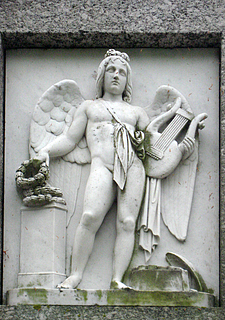
Fig. 7. The Establishment of Provincial Consultative Chambers. Marble, cf. A605. The right side of the monument.
On the right side of the monument is the relief The Establishment of Provincial Consultative Chambers, cf. A605, which shows a genie holding a coiled sheet with the royal decree about the introduction of the Consultative Chambers. May 28 1831 is the date of the establishment of the Provincial Consultative Chambers.
The four reliefs with their allegorical references all, with the possible exception of The Establishment of Provincial Consultative Chambers, cf. A605, symbolize the power of the absolute monarch, who through his government watches over the people’s interests as regards both general education, the rule of law, and freedom. The ferment of the period is clearly revealed in the relief The Establishment of Provincial Consultative Chambers, whose message radically contradicts the paternal absolutism because the population is given a voice in political life. However, the relief Justice, with its apparent homage to the absolute monarch, is also rather provocative when looked at more closely. On the scales of Justice, the farmer’s sickle and the king’s crown are weighed at the same time. This clearly means that they are both equally heavy. The egalitarian ideals of freedom cannot be expressed more clearly.

Fig. 8. Marble bust of Frederik VI in colossal size at the top of the monument. Slightly damaged by the elements. Cf. A191.
Each of the reliefs adorns one side of a large block of granite with Frederik VI’s bust at the top. Thorvaldsen had already modelled this bust, A191, during his stay in Denmark in 1819-20, but it was now carved in a very large marble version. The bust is also adorned with a laurel wreath. In this way, the granite column of the monument is completed with its central character as a classical Roman imperator with a clear reference to Frederik VI’s absolute status.
Thus, Thorvaldsen largely fulfilled the wishes of the Frederik VI Commission. Their first two wishes, The Abolition of Villeinage and The Establishment of Provincial Consultative Chambers are directly depicted in the monument, cf. A604 and cf. A605. The reference to the Education Act is slightly less directly expressed in the relief Protection of the Arts and Sciences, cf. A607. Frederik VI had also been instrumental in the reopening in 1826 of Sorø Academy, which soon became the centre of the Golden Age in Denmark with Ingemann as a pivotal figure. The relief could also be seen as Thorvaldsen’s personal tribute to Frederik VI for his support of Thorvaldsen’s art and, perhaps, a mischievous reference to his successor Christian VIII, who was actually more interested in art than his predecessor Frederik VI. The relief Justice, cf. A606, may refer to Frederik VI’s status as the country’s highest legislator and judge but rather more to his motto God and the Just Cause. The desired medallion of Frederik VI became instead an allegorical portrait of the absolute monarch in the form of Justice, while Frederik’s bust crowned the monument.
The enormous block of granite weighing around 16 tons was transported to Skanderborg with great difficulty and carved there. The transport was a great event with lots of spectators who were curious to see the stone for the royal monument. For the monument, Ingeman had composed a poem of four stanzas, one for each of the reliefs:
IN LOVING MEMORY OF FREDERIK VI THE PEOPLE ERECTED THIS MONOLITH
GUD AND JUSTICE WERE IN HIS SHIELD HIS DEEDS SPEAK OF LOVING RIGHTEOUSNESS.
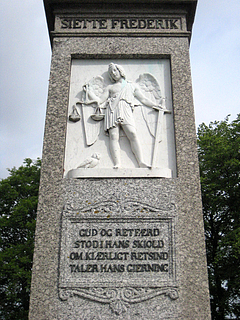
Fig. 9. The front of the monument with Justice, cf. A606, and the first stanza of Ingemann’s poem.
THE ANGEL OF FREEDOM STOOD BEFORE HIS EYES AND THE YOKE WAS BROKEN THE CHAINS SHATTERED.
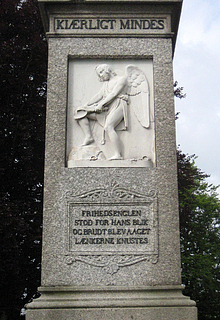
Fig. 10. The left side of the monument with The Abolition of Villeinage, cf. A604, and the second stanza of Ingemann’s poem.
PAVILLIONS OF THE SPIRIT AROSE FROM HIS HAND AND SPIRITUAL DEEDS SHONE FROM THE NORTH

Fig. 11. The back of the monument with Protection of the Arts and Sciences, cf. A607, and the third stanza of Ingemann’s poem.
THE KING GAVE A VOICE TO THE SPIRIT OF THE PEOPLE HIS MEMORY LIVES WITH THE PEOPLE
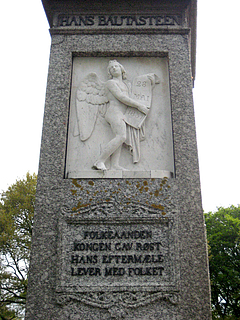
Fig. 12. The right side of the monument with The Establishment of Provincial Consultative Chambers, cf. A605, and the fourth stanza of Ingemann’s poem.
The last stanza in particular, connected to A605, is interesting: “The King gave a voice to the spirit of the people”. The absolute monarch’s “gift” to the people in the form of the consultative chambers has created a union of the power of the king and the power of the people, whereby the memory of the king is closely connected with the people. The memory of the king is not the king’s possession.
The monument was designed by the architect G.F. Hetsch. It was erected in the middle of the park on the hill at Skanderborg Castle, on the site of the courtyard of the demolished Skanderborg Castle. At the same time, the entire hill was transformed into a large park. The monument covers an area of 47.7 m2. The granite base stands on a platform with three steps in paler granite. The monument rises 7.05 m above the ground, and the bust itself measures 1.28m. The entire monument is surrounded by an iron fence cast by Meulengrath and Bøgh’s iron foundry in Aarhus.
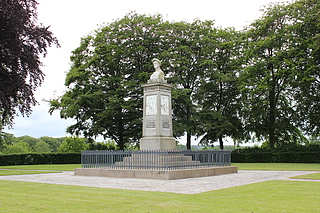
Fig. 13. The monument in full.
The reliefs were modelled in clay by Thorvaldsen and carved in marble in a larger size by C.F. Holbech, who was leader of Thorvaldsen’s workshops in Rome during his absence 1841-43, and they were then shipped to Denmark. It was not until the beginning of 1843 that it was possible to announce the final form of the monument in the press even though only about 8,000 rix-dollars or 2/3 of the final cost of the monument had been collected. It is clear that the works were being carved in marble at the turn of 1842/43 from Holbech’s request for money to buy marble, which Thorvaldsen sent after receiving money from the Frederik VI Commission. It is true that Thorvaldsen had agreed to execute the reliefs for free and gave the marble bust as a personal gift, but money was still needed for Holbech’s carving of the reliefs in marble. It was not only Thorvaldsen’s works that cost money, but installation was expensive. In 1840, With estimated that the total price would amount to 14,000 rix-dollars, but the lack of a balance sheet makes it difficult to establish the final price. In November 1842, the Frederik VI Commission announced that almost 8,000 rix-dollars had been collected, well short of the 14,000. It seems probable that not all of the money had been collected at the time of the inauguration in 1845 since the king had to lend a helping hand the following year and contribute the sum of 1,600 rix-dollars.
After some delay, the monument was finally finished in 1845. In celebration, the Frederik VI Commission planned an inaugural ceremony, which they advertised widely. It took place in July 1845, and King Christian and Crown Prince Frederik even announced that they would attend together with other celebrities, among them H.C. Andersen. It was quite a large celebration – all sources estimate that about 20-30,000 people were present, but this cannot be verified with certainty. Still, it was a great event. At any rate, the sensitive H.C. Andersen complained of the great disorder on the site, and he maintained that he could hear neither the speeches nor the songs, which included a cantata composed for the occasion by J.P. Hartmann. H.C. Andersen himself had written the text. Newspaper notices in the following days also mentioned lost objects and an auction in which items remaining from the celebration were to be sold. There were also positive comments in various newspapers. All things considered, it was a festive ending to the work that had gone into the monument, including Thorvaldsen’s, who had died the year before the inauguration.
Liberal “Monument Mania”
The ceremony and the Frederik VI Commission’s promotion of the monument overshadowed the widespread criticism in the years before. The first critical voices were heard soon after the first public mention of a monument to Frederik VI in 1840. The editor of the newspaper Jyllandsposten attacked the proposal made by Dalgas and Ingwersen. Among other things, he found it difficult to see Frederik VI’s connection with Skanderborg and suggested Aarhus instead (not surprisingly since Jyllandsposten was located in Aarhus). He also feared acts of vandalism against an unprotected monument in natural surroundings. The members of the Frederik VI Commission did not share his concern.
However, after these practical objections he arrived at the heart of his criticism. One should not pay tribute to a sovereign like Frederik VI because of the misfortunes the country had experienced during his reign. Even though Dalgas and the editor largely agreed in demanding a free constitution, they disagreed as to whether any tribute should be paid to Frederik VI. Dalgas resorted to a familiar excuse of this period, i.e. that the King’s counsellors rather than the King himself ought to be criticized for the misfortunes of the country. This was a practical way out as a certain risk was involved in criticizing the person of the king. However, the point of dispute remained the great setbacks that the country experienced during the years 1807-15. This also appears in later critical comments, most of which were anonymous, perhaps for fear of reprisals. By far the majority of both the critics and the supporters of the monument recognized Frederik VI’s efforts for the farmers, his personal asceticism as well as his responsibility for the catastrophes of the years 1807-15. In short, the question was what was most important for the country: The nobility’s and the merchants’ loss of influence in European politics or the constitutional rights of the agricultural community? It was not just the obvious calamities of the English Wars that were adduced as a reason to ignore Frederik VI’s reign. The serious situation that had arisen as a consequence of the national tensions between the Kingdom of Denmark and the Duchies of Schleswig and Holstein cast a shadow over the political climate of the realm. This problem flared up with great force in 1848, a mere nine years after Frederik’s death, so the fear was certainly not unfounded. Combined with a restriction of the freedom of the press, it was the opinion of several debaters that Frederik VI had not handed the realm to his successor Christian VIII in a healthy condition. The view of Frederik VI’s incompetence as a sovereign was not merely the result of the calamities of the early years of the reign. Moreover, Frederik VI’s supporters also disagreed about the form of the monument and proposed other kinds of commemoration than a monolith. Several critical voices spoke against the “Monument Mania” of the time and suggested the establishment of a folk high school for the general education of agricultural youth, thus demonstrating that there was a difference between a “living house and a dead stone”. A monolith would symbolize a “petrified” love instead of a life-giving love. The farmer was the life-giving force of the country. If one wanted to celebrate the new status of the farmer in society, it should be done through useful projects such as a folk high school, a new hymnbook, or a charitable institution for the poor, and not through an expensive and useless block of granite.
It can be confusing for modern readers that many liberal farmers pleaded so eagerly in favour of a monument to Frederik VI. Of course, the abolition of villeinage, the decree about the abolition of the slave trade in 1792 (even though slavery was not abolished until 1848), and the introduction of the Consultative Chambers were in keeping with the liberal spirit. As a young crown prince Frederik had introduced reforms at the advice of competent counsellors, and as an old king he had done so unwillingly and under great pressure. It was possible to celebrate these liberal reforms, but why mention Frederik VI? At the time, it caused confusion and gave rise to pointed remarks to the effect that these otherwise critical farmers had suddenly acknowledged Frederik VI’s greatness as a sovereign after his death. Whether they supported Frederik VI or not, both parties were probably aware that a tribute to Frederik VI in this connection was secondary. With a cautious and pragmatic monument, the liberal farmers had a better possibility of being heard politically than if they had chosen a more confrontational course vis-à-vis the monarchy. In erecting a monument, there was a greater chance of success if the monarchy was involved instead of being openly challenged.
Discreet Tribute or Hidden Protest?
The two messages of the monument, the emphasis on royal power and the praise of the democratic initiatives of that same royal power are apparently contradictory. The monument to Frederik VI in Skanderborg was a discreet tribute to the absolute monarchy to the extent that the monarchy served the interests of the social class that the members of the Frederik VI Commission belonged to. Inherent in the tribute of the monument was the equally if not more important political protest of that class against the absolute monarchy’s slowness in introducing a free, democratic constitution. This may be seen in e.g. the designation and the location of the monument. The monument is referred to as a memorial column and not as a liberty column as such a designation could only be used when a free constitution had been given to the people. The location of the monument at Skanderborg was well chosen since its relation to the monarchy was clearly emphasized. Thus it was irrelevant whether Frederik VI had any personal connection with Skanderborg – indeed, one could say that Frederik VI was merely an excuse to erect the monument with its liberal messages. The tribute to Frederik VI’s progressive reforms was meant to remind the new king Christian VIII of his responsibility to introduce a free constitution almost as much as to pay tribute to Fredrik VI for his reforms. It is true that progress had been made during the reign of the old King, but the work was far from finished with a few consultative chambers.
Of course, one should not underestimate the existence of sincere loyalty to the monarchy and pleasure in being able to “embellish” one’s native land with a monument executed by one of Europe’s most famous artists, Bertel Thorvaldsen. However, the farmers did not have many ways to communicate their political messages in a society marked by the censorship of absolutism. Therefore, they could not consider the voices that criticized the project for paying tribute to a king who, in their eyes, had been a catastrophically bad sovereign for the country. The most important thing about Frederik VI’s reign in the eyes of the Frederik VI Commission and its supporters was not the memory of Denmark’s loss of its status as a Great Power even though they admitted that Frederik VI had been responsible for this. To them, it was far more important to mention the elements in the governing of the country that had benefitted the farmers. In this way, they indirectly introduced political demands in a monument that immediately appeared as a popular tribute to the paternal monarchy. They wanted action on the part of the new King Christian VIII, in short a free constitution. Things could not be said directly due to the risk of fines or imprisonment. This explains the ambiguity of the monument. The liberal farmers had to be pragmatic in their protest against the monarchy and erected a monument that at the first glance appears to be an unequivocal tribute to Frederik VI, but by a creative use of allegories actually carries another, ill-concealed message. Therefore, if the message of the monument appears confusing to modern observers, it is because the people who commissioned the monument as well as the artist of the work, Thorvaldsen, actually were bitter critics of the absolute monarchy.
At the same time, the location of the monument was in a certain way also a protest against the absolutist centralization of power and representation in Copenhagen. By paying tribute to the monarchy also outside the capital, they managed to put the farmers on the political agenda, a class that had not previously played a role in political life. During this period marked by frustrated wishes for political change, it makes excellent sense that an artist like Thorvaldsen contributed a work of this kind even though it may seem incomprehensible to people of today that he paid tribute to an absolute ruler. He was able to show his personal respect for Frederik VI through this monument without compromising his ideals of freedom. The monument was an obvious platform for both Thorvaldsen and the farmers to promote these ideals but in such a way that the monarchy ended up by sanctioning the monument. Thus, the monument became part of the liberal pressure on King Christian VIII to introduce a democratic constitution and an essential art-historical contribution to the history of the emergence of Danish democracy..
References
- Dokumenter vedrørende emnet Frederik 6.s monument, Skanderborg Slotsbanke.
- Inge Adriansen: Erindringssteder i Danmark – monumenter, mindesmærker og mødesteder, København 2010.
- H.C. Andersen: Mit livs eventyr, København 1951.
- Svend Cedergreen Bech (ed.): Dansk Biografisk Leksikon tredje udgave, København 1979-84.
- Jens Engberg: Den standhaftige tinsoldat – en biografi om Frederik 6., København 2009.
- Christian Holtet: Kong Frederik den Sjettes mindesmærke paa Skanderborg Slotsbanke – udarbejdet til Hundredaarsdagen for mindesmærkets afsløring den 31. juli 1845, Skanderborg 1945.
- V. Richter: 100 Aars Dødsfald (1791-1890), København 1905 (1976).
- L. Thane: Skanderborgs historie – samlet i anledning af købstadens 325 aars jubilæum, Skanderborg 1908.
- Just Mathias Thiele IV: Thorvaldsen i Kiøbenhavn. 1839-1844, København 1856.
- Just Mathias Thiele 1850: Den danske Billedhugger Bertel Thorvaldsen og hans Værker, København 1850.
- Carl Frederik Wilckens: Træk af Thorvaldsens Konstner- og Omgangsliv, samlede til Familielæsning, København 1874.
Works referred to





Last updated 20.11.2020